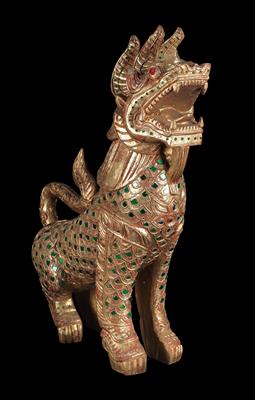Burma (Myanmar): a typical Burmese guardian lion, called a ‘chinthe’. Covered in gold leaf and richly decorated.
Burma (Myanmar): a typical Burmese guardian lion, called a ‘chinthe’. Covered in gold leaf and richly decorated.

Larger versions of ‘chinthe’ guardian lions such as this one are positioned in pairs to the left and right of the entrances to temples, pagodas and smaller shrines across Burma. Chinthe generally have a lion’s body and a lion’s head with an open mouth and fangs. However, this mythical being can also be combined with parts of other animals, such as dragon’s heads or human heads, elephant’s trunks or wings. They exist in larger sizes made of stone or of plastered brickwork, and in smaller sizes made of bronze, wood, such as the present guardian lion, or of other materials. Small chinthes are also used as good luck amulets for personal success in daily life. In addition, the chinthe guardian lion is used in the old Burmese calendar as the symbolic animal for the third day of the week (Tuesday). The present chinthe guardian lion probably originates form a small shrine or a domestic altar. It is carved from light-coloured, hard wood (probably teak). All the exterior surfaces are richly decorated with detailed thayo relief (see cat. no 293) with green, blue, red and white mirrored plaques, underpainted with red lacquer and topped with gold leaf. A highly decorative object without significant damage.
Dimensions: 64 cm x 16 cm x 46 cm. First half of the 20th century. (ME)
Specialist: Erwin Melchardt
 Erwin Melchardt
Erwin Melchardt
+43-1-515 60-465
erwin.melchardt@dorotheum.at
06.04.2017 - 15:00
- Realized price: **
-
EUR 750.-
- Starting bid:
-
EUR 600.-
Burma (Myanmar): a typical Burmese guardian lion, called a ‘chinthe’. Covered in gold leaf and richly decorated.
Larger versions of ‘chinthe’ guardian lions such as this one are positioned in pairs to the left and right of the entrances to temples, pagodas and smaller shrines across Burma. Chinthe generally have a lion’s body and a lion’s head with an open mouth and fangs. However, this mythical being can also be combined with parts of other animals, such as dragon’s heads or human heads, elephant’s trunks or wings. They exist in larger sizes made of stone or of plastered brickwork, and in smaller sizes made of bronze, wood, such as the present guardian lion, or of other materials. Small chinthes are also used as good luck amulets for personal success in daily life. In addition, the chinthe guardian lion is used in the old Burmese calendar as the symbolic animal for the third day of the week (Tuesday). The present chinthe guardian lion probably originates form a small shrine or a domestic altar. It is carved from light-coloured, hard wood (probably teak). All the exterior surfaces are richly decorated with detailed thayo relief (see cat. no 293) with green, blue, red and white mirrored plaques, underpainted with red lacquer and topped with gold leaf. A highly decorative object without significant damage.
Dimensions: 64 cm x 16 cm x 46 cm. First half of the 20th century. (ME)
Specialist: Erwin Melchardt
 Erwin Melchardt
Erwin Melchardt
+43-1-515 60-465
erwin.melchardt@dorotheum.at
|
Buyers hotline
Mon.-Fri.: 10.00am - 5.00pm
kundendienst@dorotheum.at +43 1 515 60 200 |
| Auction: | Tribal Art |
| Auction type: | Saleroom auction |
| Date: | 06.04.2017 - 15:00 |
| Location: | Vienna | Palais Dorotheum |
| Exhibition: | 01.04. - 06.04.2017 |
** Purchase price incl. buyer's premium and VAT
It is not possible to turn in online buying orders anymore. The auction is in preparation or has been executed already.
